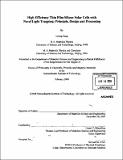| dc.contributor.advisor | Lionel C. Kimerling. | en_US |
| dc.contributor.author | Zeng, Lirong, Ph. D. Massachusetts Institute of Technology | en_US |
| dc.contributor.other | Massachusetts Institute of Technology. Dept. of Materials Science and Engineering. | en_US |
| dc.date.accessioned | 2009-01-30T16:41:15Z | |
| dc.date.available | 2009-01-30T16:41:15Z | |
| dc.date.copyright | 2008 | en_US |
| dc.date.issued | 2008 | en_US |
| dc.identifier.uri | http://hdl.handle.net/1721.1/44392 | |
| dc.description | Thesis (Ph. D.)--Massachusetts Institute of Technology, Dept. of Materials Science and Engineering, 2008. | en_US |
| dc.description | Includes bibliographical references. | en_US |
| dc.description.abstract | One major efficiency limiting factor in thin film solar cells is weak absorption of long wavelength photons due to the limited optical path length imposed by the thin film thickness. This is especially severe in Si because of its indirect bandgap. This thesis invents a novel light trapping scheme, the textured photonic crystal (TPC) backside reflector, which can enhance path length by at least several hundred times the film thickness for sufficient absorption. Physical principles and design optimization of TPC are discussed in detail. Thin film Si solar cells integrated with the new back reflector are successfully fabricated and significant efficiency enhancement is demonstrated.The new back reflector combines a one-dimensional photonic crystal as a distributed Bragg reflector (DBR) and reflection grating. The DBR achieves near unity reflectivity in a wide omnidirectional bandgap completely covering the wavelengths needing light trapping, and the grating can diffract light into large oblique angles and form total internal reflection against the front surface of the cell. The unique combination of DBR and grating tightly confines light inside the cell, effectively changing the path length from the thickness of the cell to its width.The back reflector parameters and the antireflection coating are systematically optimized for thin film Si solar cells through simulation and experiments. A 2 [mu]m thick cell can achieve 54% efficiency enhancement using the optimized design.For proof of concept, the TPC back reflector is integrated with thick crystalline Si solar cells (675 [mu]m thick), which demonstrate external quantum efficiency enhancement up to 135 times in the wavelength range of 1000-1200 nm. | en_US |
| dc.description.abstract | (cont.) To prove the theory on the intended application, top-contacted thin film Si solar cells integrated with the TPC back reflector are successfully fabricated using Si-on-insulator material through an active layer transfer technique. All cells exhibit strong absorption enhancement, similar to that predicted by simulation. The 5 [mu]m thick cells gained 19% short circuit current density improvement, despite machine problems during fabrication. The textured photonic crystal back reflector design can be applied directly to single and poly-crystalline Si solar cells, and its principle is broadly applicable to other materials systems. | en_US |
| dc.description.statementofresponsibility | by Lirong Zeng. | en_US |
| dc.format.extent | 237 p. | en_US |
| dc.language.iso | eng | en_US |
| dc.publisher | Massachusetts Institute of Technology | en_US |
| dc.rights | M.I.T. theses are protected by
copyright. They may be viewed from this source for any purpose, but
reproduction or distribution in any format is prohibited without written
permission. See provided URL for inquiries about permission. | en_US |
| dc.rights.uri | http://dspace.mit.edu/handle/1721.1/7582 | en_US |
| dc.subject | Materials Science and Engineering. | en_US |
| dc.title | High efficiency thin film silicon solar cells with novel light trapping : principle, design and processing | en_US |
| dc.type | Thesis | en_US |
| dc.description.degree | Ph.D. | en_US |
| dc.contributor.department | Massachusetts Institute of Technology. Department of Materials Science and Engineering | |
| dc.identifier.oclc | 277140405 | en_US |
